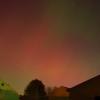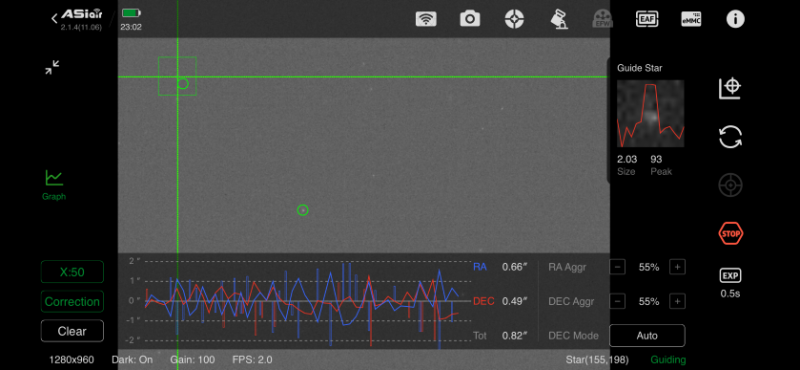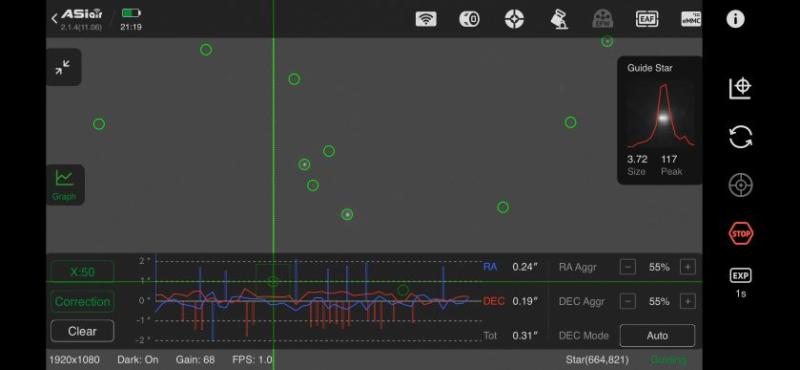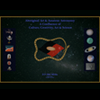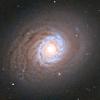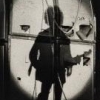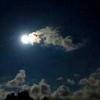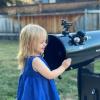
AM5 Guiding in Light Pollution
#1

Posted 08 May 2024 - 11:11 PM
I’m pushing around a AstroTech AT130EDT with a .8 reducer on an AM5, and depending on the seeing and conditions I average between .5 and .8 RMS guiding with my ASIAir but it does bounce above 1.0-1.1 and I’m hoping to do better because at some point I’m hoping to switch to a 1x reducer.
From my back yard (somewhere between a Bortle 7 and 8) I frequently have trouble getting more than a few guide stars unless I max out the gain on my 120MM, even then I might only get a few guide stars and a very washed out background.
I went from a mini guide scope to a 50mm guide scope and now I have a 60mm guide scope and finally threw a UV/IR filter in front of the guide camera to get where I am now...
What I’m curious about is if the 220 will do a better job picking stars out of the light pollution.
#2

Posted 08 May 2024 - 11:30 PM
For longer FL, have had better results with a 290mm / 174mm.
At 1370mm fl, 60mm F4 guidescope, 290mm, my AM5 is consistently between 0.5 and 0.7 total. Plenty of stars for multistar guiding.
I'm in skies of 16.5 mpsas or so, so like a Bortle 11 or something. :-)
With that LP, increasing the gain introduces too much noise, so I dont go above 65% or so. I also find noise reduction (PHD2, don't know if its there in AsiAir) plus darks help a lot.
As mentioned, I have the 290mm, but have seen very good reviews of the 220mm on CN from AM5 users. Am pretty sure it will be far better than a 120mm at that fl.
You can try a search.
Sent from my SM-S908E using Tapatalk
#3

Posted 08 May 2024 - 11:30 PM
As an FYI, Planetary folks sometimes use an IR passband filter to get data to augment Lum channel data. The Astronomik ProPlanet IR-pass filter is one such filter that you may want to look into. The beauty of such a filter cuts off wavelengths in the visible spectrum which should help with your LP situation.
#4

Posted 08 May 2024 - 11:44 PM
The 220mm should be a pretty good improvement over the 120mm.
Have also set up a dark library in the asiair for guiding? This should be done no matter what camera is being.
#5

Posted 09 May 2024 - 12:04 AM
I’m torn on whether I should upgrade from an ASI120MM to an ASI220MM guide camera.
I’m pushing around a AstroTech AT130EDT with a .8 reducer on an AM5, and depending on the seeing and conditions I average between .5 and .8 RMS guiding with my ASIAir but it does bounce above 1.0-1.1 and I’m hoping to do better because at some point I’m hoping to switch to a 1x reducer.
From my back yard (somewhere between a Bortle 7 and 8) I frequently have trouble getting more than a few guide stars unless I max out the gain on my 120MM, even then I might only get a few guide stars and a very washed out background.
I went from a mini guide scope to a 50mm guide scope and now I have a 60mm guide scope and finally threw a UV/IR filter in front of the guide camera to get where I am now...
What I’m curious about is if the 220 will do a better job picking stars out of the light pollution.
If you are sure that your inability to find guide stars is due to strong light pollution and not something else such as poor focus, then you shouldn't be using a UV/IR cut filter. Light pollution is primarily in the visible part of the spectrum, and by using that filter you are cutting off useful signal and reducing SNR, which is the most important factor for good guiding. But with regard to your question about ASI220MM, yes it will definitely help - it's more sensitive, especially in IR, and it has a larger sensor. It also has very small amount of read noise, which helps with guiding an AM5 with short exposure.
- Skysmacker likes this
#6

Posted 09 May 2024 - 11:32 AM
Thanks for the input guys,
The UV/IR filter definitely felt like it improved the guiding and I'd like to believe I have the scope dialed in pretty close for focus. I don't quite have the experience to say if its the guide scope, the camera (maybe its defective?!) or just the AA+ PHD2 configuration. Bumping from the Mini Guide Scope > 50mm > 60mm and then finally adding the UV/IR filter is where I am today and as you can see below, its definitely usable at ~700mm but as I said before, jumping to a 1x reducer (~900mm) is going to be trouble...
The following image is pretty typical for me (Last nights imaging session for Markarian's Chain):
It will usually start out with more stars and then slowly lose them one by one until I'm down to 2-3 guide stars (I'm running the latest beta for the AA+), for me as the gain goes up I get more stars but as you all know you also get more noise and the contrast is pretty terrible. On some nights I can get away with 1-2 second guiding with a gain around 30-50 but at .25-.5 second guiding I have to crank the gain up to 80-100...
I just ordered a 220mm from Agena, so that should hopefully arrive in the next day or so and the sky looks to be somewhat clear for the next few days, we'll see how it goes...
#7

Posted 13 May 2024 - 05:23 PM
The 220mm arrived a few days ago and made a pretty substantial difference in finding guide stars...
With zero gain last night I was able to grab and hold on to 12 guide stars (I don't think I have ever seen the 120mm pick out 12 guide stars from my back yard) and averaged around .4rms until the clouds came in...
- acrh2 likes this
#8

Posted 13 May 2024 - 07:07 PM
The 220mm arrived a few days ago and made a pretty substantial difference in finding guide stars...
With zero gain last night I was able to grab and hold on to 12 guide stars (I don't think I have ever seen the 120mm pick out 12 guide stars from my back yard) and averaged around .4rms until the clouds came in...
Glad it's working out for you. If you ditch that UV/IR filter, you'll get even more stars.






